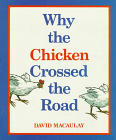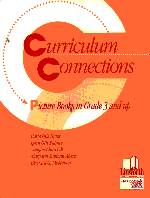Black and White by David Macaulay

by Macaulay, David. (Houghton, 1990 ISBN 9780395521519. Order Info.) Picture Book. Grades 1+.

This is an excerpt from Curriculum Connections by Carol Otis Hurst, Lynn Otis Palmer, Vaughn Churchill, Margaret Sullivan Ahearn, Bernard G. McMahon. Linworth Publishing, 1999. ISBN 0938865706. Order Online.
SUMMARY

What appear to be four separate stories, one installment of each appearing on each spread of the book, turn out to intermingle and, in time, become one story. Always Macaulay is playing with our perceptions and making allusions and illusions. A robber hides out in a herd of cattle who, in turn, disrupt the passage of a train. At the train station, passengers at first are absorbed in the newspapers they are reading, but as the wait lengthens, they start playing with the newspapers and with each other. A boy, a passenger on the train, witnesses some of the events, but not all of them. Parents, previously staid and distant, have apparently changed, at least temporarily, because of their time spent waiting for the train that day. The book can be frustratingly confusing or, in the proper hands and minds, a challenge and a source of fascination.
ILLUSTRATIONS
Sorting out the myriad images in this book is a bit like watching the multiple pictures on a split screen TV. It's essential to revisit these pictures again and again in order to appreciate or calculate the variety of illustration styles. One way to observe how David Macaulay manages a time sequence is to flip through the book quickly and observe the change in the crowd at the train station. Inventiveness is the key word for this publication.
Finding Details
Look at the back cover of the book. There appears to be a cow but look closer and you will see a human figure in the pattern. Where is the figure pointing? Is there a title in the book he may be referring to? If he is, what might he be telling you about reading this book? Can you find the same figure elsewhere in the book? Who is he? What does he tell you at various points?
Building Vocabulary
The title of one story, "Udder Chaos" is a pun. Find other examples of puns in jokes, riddles and story titles. Put them on a bulletin board.
Extending the Text
The title of the book is not printed in black and white on the cover, although that might be a logical thing to do. Notice the way it is printed there and on the spine of the book and the colors Macaulay uses. What do you think is meant?
Find and tell many answers to the riddle question, "What's black and white and red all over?" Take a poll about the answers to this question and find out the most commonly known answer. Macaulay never mentions that riddle, but you can find the ways he uses it throughout the book.
Notice where and how the robber hides. Often it is among black and white things: the cows and the choir. What else could he have hidden among if they were in the book? Penguins? Draw pictures with other such places to hide the robber.
Sometimes the words in the book help explain the illustration; sometimes they contradict the illustration. Make a chart similar to the one below and find instances of each.
| TEXT AND ILLUSTRATIONS MATCH | TEXT AND ILLUSTRATIONS DON'T MATCH |
| "An old woman enters the compartment" | "The worst thing about Holstein cows is that if they ever get out of the field, they're almost impossible to find." |
| "Every morning at seven o'clock they leave for their offices in the city." | "The boulders are moving" |
| "The man is shouting and waving his fists.: | "He sticks out his hand to catch a few flakes." |
Look at the author's picture on the flap of the book. Why do you think he shows himself in a make-believe train?
Make a time line of the events in the story. What do you think happened first?
Read the author's warning on the title page of the book. Did you heed it? What difference would it make?
Look carefully at the first and last pictures in the book. Do you know where the train station came from?
The dog in the story "Problem Parents" may remind you of the dog in the books by Chris Van Allsburg. Find out if the two authors know each other and, if so, how they met.
You could say that the newspapers are a symbol in this book from beginning to end. List all the things you think of about newspapers: what are they for? what do we do with them? Then think of ways Macaulay used these ideas in his book.
Author Study
Find and read all or parts of David Macaulay's acceptance speech for the Caldecott Award he received for Black and White. In it he explains a little of what he was trying to do in the book. He also has four parts to his speech and they are the titles of each of the stories in his book but they have a different meaning there.

Comparing Literature
Look at Macaulay's book Why the Chicken Crossed the Road? (Houghton, 1987 ISBN 0395442419. Library Binding. Paperback.) Could that book have come before or after this one? Is it the same robber? the same cows?
Find other books where the artists play with our perspective such as Zoom, and Bad Day at Riverbend.
SCIENCE
Almost everything that happens in this book affects something or someone else. Make a list of every action in the story and beside it, put the things that action caused to happen. Then, take any eco-system such as a pond, a field, or a woods. List a series of events that might take place within that eco-system during a day or a season and show how it affects other things in the system.
ART
Both the art and the text of this book use positive and negative space. (There's as much in what the words don't say as there is in what they do say.) Do some art activities using negative and positive images. Start by cutting a shape from a piece of construction paper and then pasting both the shape and the piece it's cut out of on another paper in a pleasing manner. Go on from this start to create your own work of art.
RELATED BOOKS

Novels:
Fleischman, Paul. Bull Run. HarperCollins, 1993 ISBN 0064405885. Paperback. Hardcover. Cassette. Grades 4 - 9
Each chapter presents a different viewpoint as various people head to the battle of Bull Run.
Picture Books:
Banyai, Istvan. Zoom. Viking, 1995 ISBN 0670858048. Library Binding. Paperback.
We play with perspective zooming out from a small detail into a series of ever widening views.
Van Allsburg, Chris. Bad Day at Riverbend. Houghton, 1995. ISBN 039567347X. Library Binding.
Why the Chicken Crossed the Road. Houghton, 1987 ISBN 0395442419. Library Binding. Paperback.
The riddle in this book is more obvious than in Black and White but it is the cause of a whole series of events and hilarity.
![]()

Related Areas within Carol Hurst's Children's Literature Site
- Fleischman, Paul. Bull Run. Book Review.
- Curriculum Connections by Carol Otis Hurst. Info on professional book.
- Trains and Children's Literature. A featured subject with books, activities and related links.
![]()
Related Areas on the Internet
- Amazon.com Bookstore's listing of David Macaulay's books.
- Yahoo's listings of sites about David Macaulay and his books.
Advertisement:
Advertisement:
Advertisement:

